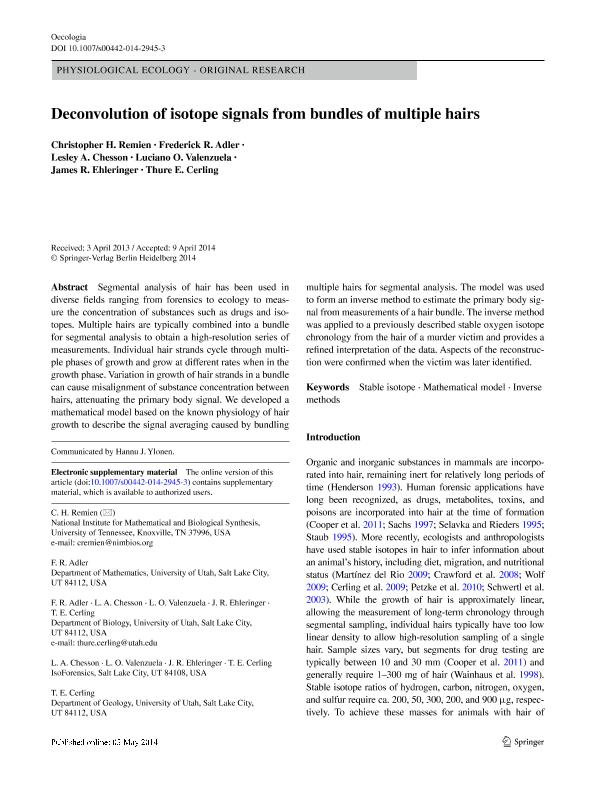Mostrar el registro sencillo del ítem
dc.contributor.author
Remien, Christopher H.
dc.contributor.author
Adler, Frederick R.
dc.contributor.author
Chesson, Lesley A.
dc.contributor.author
Valenzuela, Luciano Oscar

dc.contributor.author
Ehleringer, James R.
dc.contributor.author
Cerling, Thure E.
dc.date.available
2018-01-12T22:22:31Z
dc.date.issued
2014-05
dc.identifier.citation
Chesson, Lesley A.; Adler, Frederick R.; Valenzuela, Luciano Oscar; Cerling, Thure E.; Remien, Christopher H.; Ehleringer, James R.; et al.; Deconvolution of isotope signals from bundles of multiple hairs; Springer; Oecologia; 175; 3; 5-2014; 781-789
dc.identifier.issn
0029-8549
dc.identifier.uri
http://hdl.handle.net/11336/33205
dc.description.abstract
Segmental analysis of hair has been used in diverse fields ranging from forensics to ecology to measure the concentration of substances such as drugs and isotopes. Multiple hairs are typically combined into a bundle for segmental analysis to obtain a high-resolution series of measurements. Individual hair strands cycle through multiple phases of growth and grow at different rates when in the growth phase. Variation in growth of hair strands in a bundle can cause misalignment of substance concentration between hairs, attenuating the primary body signal. We developed a mathematical model based on the known physiology of hair growth to describe the signal averaging caused by bundling multiple hairs for segmental analysis. The model was used to form an inverse method to estimate the primary body signal from measurements of a hair bundle. The inverse method was applied to a previously described stable oxygen isotope chronology from the hair of a murder victim and provides a refined interpretation of the data. Aspects of the reconstruction were confirmed when the victim was later identified.
dc.format
application/pdf
dc.language.iso
eng
dc.publisher
Springer

dc.rights
info:eu-repo/semantics/openAccess
dc.rights.uri
https://creativecommons.org/licenses/by-nc-sa/2.5/ar/
dc.subject
Stable Isotope
dc.subject
Mathematical Model
dc.subject
Inverse Methods
dc.subject.classification
Otras Ciencias Biológicas

dc.subject.classification
Ciencias Biológicas

dc.subject.classification
CIENCIAS NATURALES Y EXACTAS

dc.subject.classification
Historia

dc.subject.classification
Historia y Arqueología

dc.subject.classification
HUMANIDADES

dc.title
Deconvolution of isotope signals from bundles of multiple hairs
dc.type
info:eu-repo/semantics/article
dc.type
info:ar-repo/semantics/artículo
dc.type
info:eu-repo/semantics/publishedVersion
dc.date.updated
2016-11-23T19:56:23Z
dc.identifier.eissn
1432-1939
dc.journal.volume
175
dc.journal.number
3
dc.journal.pagination
781-789
dc.journal.pais
Alemania

dc.journal.ciudad
Berlin
dc.description.fil
Fil: Remien, Christopher H.. University of Tennessee; Estados Unidos
dc.description.fil
Fil: Adler, Frederick R.. University of Utah; Estados Unidos
dc.description.fil
Fil: Chesson, Lesley A.. University of Utah; Estados Unidos
dc.description.fil
Fil: Valenzuela, Luciano Oscar. University of Utah; Estados Unidos. Consejo Nacional de Investigaciones Científicas y Técnicas; Argentina
dc.description.fil
Fil: Ehleringer, James R.. University of Utah; Estados Unidos
dc.description.fil
Fil: Cerling, Thure E.. University of Utah; Estados Unidos
dc.journal.title
Oecologia

dc.relation.alternativeid
info:eu-repo/semantics/altIdentifier/url/https://link.springer.com/article/10.1007/s00442-014-2945-3
dc.relation.alternativeid
info:eu-repo/semantics/altIdentifier/doi/http://dx.doi.org/10.1007/s00442-014-2945-3
Archivos asociados
